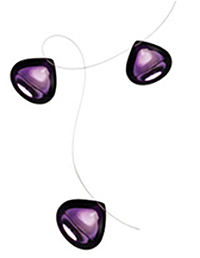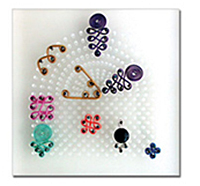Have a Beading Question? Ask Sara!
Common Beading Questions
What is the difference between Soft Flex® Wire and Soft Touch™ Wire?
Oh, if I had a nickel for every time I have heard this question! Soft Flex® Wire was originally created by the owners of Soft Flex® Company over 12 years ago. It was innovative, cutting edge, stronger and more flexible then any other bead stringing products on the market. Soft Touch™ Wire was introduced about 7 years ago. It is untouched in the industry for flexibility. It is just as strong as our Soft Flex® Wire, but it drapes like a thread. With this product line, we also introduced a whole new diameter - .010. This Very Fine diameter is just for sewing, crocheting, knitting and weaving. Soft Flex® Wire is still wonderful and is especially nice because it comes in a huge array of colors. In such a colorful craft, colored wire can be very important. It is also available in the bright metallic tones: Sterling Silver Extreme 925™ Flex Wire and Soft Flex® 24K Gold Flex™. So, that is the difference between these two supreme product lines!
 What diameter of wire should I choose for my design?
What diameter of wire should I choose for my design?
That will depend on what beads you are stringing or what type of design you are creating. Here is a pretty easy to follow guide for each of our diameters:
There are 3 stringing diameters in Soft Flex® Wire and Soft Touch™ Wire. It is important that you choose the correct one for your needs. Most problems with stringing occur when someone has chosen the wrong diameter for the type of beads that they are using in their design.
.014 is designed for softer, less abrasive materials such as fresh water pearls and seed beads. Diameter .014 offers the softness and flexibility of pearl stringing threads yet has the strength of stainless steel.
.019 is designed for use with small to medium glass beads, crystals, silver, pewter, 80% of freshwater pearls and seed beads. This diameter is recommended when you are designing with a variety of materials.
.024 is designed for abrasive materials and designs that will meet excessive movement such as watch bands, bracelets, belts and purse straps. It is great for African trade beads, lampwork and large gem stones.
There is one additional diameter in Soft Touch™ Wire. The World's first Stainless Steel Beading Thread! Designed for Sewing, Crocheting and Knitting, .010 Soft Touch™ Wire is constructed of 7 micro stainless steel wires. As soft as thread, with the strength of steel, this diameter is widely used for illusion style necklaces. The 1x1 Soft Flex® Crimp Tube is typically recommended for diameter .010 in Soft Touch™ Wire and should be crimped with the Micro Crimping Pliers.
 What is the best way to finish a single strand design?
What is the best way to finish a single strand design?
I always suggest crimping to finish almost any Soft Flex® Wire or Soft Touch™ Wire design. We manufacture Soft Flex® Crimp Tubes that are double the wall thickness of most tubes on the market. They are also seamless. They are very durable and look fantastic when crimped with the Crimping Pliers. It is really important that you use the right diameter of wire, a high quality crimp tube and crimp properly with the Crimping Pliers. With a single strand of .014 or .019, you will use a 2x2 crimp tube. With a single strand of .024, you will use a 2x3 crimp tube. Click for easy to follow Crimping instructions.
 How do I finish a multiple strand necklace?
How do I finish a multiple strand necklace?
There are lots of different ways for finishing off a multiple strand design. Here are 3 of my favorite!
First, you can always use a multiple strand clasp. Then, you can simply crimp each strand to its own loop on the clasp. There are some really beautiful and artsy multiple strand clasps available on our website.
Second, you can always crimp all of your strands to an eye pin. Then, you simply pull the eye pin through a cone and attach it to a single strand clasp with a simple wire wrap.
Third, there are now 3x3, 3x4 and 3x5 Soft Flex® Crimp Tubes available for crimping multiple strands of wire together. You will need a pair of Mighty Crimping Pliers for this application. This is quick, easy and looks great.
 What makes the Soft Flex® Company Professional Tool Line different then other tools on the market?
What makes the Soft Flex® Company Professional Tool Line different then other tools on the market?
Quality, Quality, Quality! All of the tools that we personally manufacture for our Soft Flex® Company Professional Tool Line are created by designers for designers.
These tools are manufactured in the USA. Our pliers and cutters are constructed of high grade alloy steel with ergonomic foam cushion handles. Each tool has a lap-joint. The Soft Flex® Company Professional Tool Line features, as a standard, a unique double-sheathed, ESD safe, cushioned grip. The inner sheath is a tough vinyl, ESD safe material which holds the leaf spring and the cushioned surface to the handle. The outer sheath, also ESD safe, provides a no-slip, cushioned surface for the operator's hand. This is important because the slight compressibility of the cushion aids to distribute the pressure more effectively. It can even absorb sharp particles which could be imbedded in the hand.
The Soft Flex® Company Professional Tool Line has a cushion grip that is almost always considered by operators to be more comfortable than the hard plastic used by competitors. We carry our tools in 2 handle lengths, 2.5 in. and 3.5 in., in order to allow you to find the perfect fit for your hand. We manufacture 2 types of cutters:
Flush Cutters and Razor Flush Cutters. We manufacture 4 types of pliers: Round Nose, Chain Nose, Needle Nose and a Narrow Flat Nose. What makes the WigJig® Product Line different from other jigs on the market?
What makes the WigJig® Product Line different from other jigs on the market?
Where do I begin? All WigJigs® are constructed of aircraft-strength acrylic. This material is so strong that it can be used in a vise. The best thing about using this type of material is that the peg holes will never wear out and enlarge. If you use a plastic or a wood jig, the holes will eventually grow from wear and tear. Then, the pegs slip and slide out easily, making it hard to design efficiently. Since this material is clear, you can lay your WigJig® down right on a pattern, plug in your pegs and start designing. It is not so simple or easy with a metal jig to follow a pattern. There are currently 6 WigJigs® to choose from: Olympus (5" square/large peg holes/square pattern), Olympus-Lite (3"x4" square/large peg holes/square pattern), Electra (5" square/large peg holes/round pattern), Delphi (3" square/small peg holes/square pattern), Cyclops (4.5" square/small peg holes/round pattern) and the Centaur Lite (4" square/small peg holes/square and round pattern). What crimp do I use with which wire?
What crimp do I use with which wire?
Choosing a crimp varies according to the application. Here is a rundown of the most common uses for crimps. This applies to all 4 of our wire lines.
If you are attaching a clasp to the wire, you will follow these guidelines:
.010/Very Fine-1x1mm-Micro Crimping Pliers
.014/Fine-2x2mm-Regular Crimping Pliers
.019/Medium-2x2mm-Regular Crimping Pliers
.024/Heavy-2x3mm-Regular Crimping Pliers
If you are crimping on either side of a bead to hold the bead in place:
.010/Very Fine-1x1mm-Micro Crimping Pliers
.014/Fine-1x1mm-Micro Crimping Pliers or 2x2mm-Regular Crimping Pliers (You will choose according to how big the bead hole is, use 1x1mm for smaller beads and 2x2mm for larger beads.)
.019/Medium-1x1mm-Micro Crimping Pliers or 2x2mm-Regular Crimping Pliers (You will choose according to how big the bead hole is, use 1x1mm for smaller beads and 2x2mm for larger beads.)
.024/Heavy-2x2mm-Regular Crimping Pliers
If you are crimping a multi strand design:
.014/Fine-3x3, 3x4, 3x5-Mighty Crimping Pliers (will fit 30 single strands-15 strand necklace)
.019/Medium-3x3, 3x4, 3x5-Mighty Crimping Pliers (will fit 20 single strands-10 strand necklace)
.024/Heavy-3x3, 3x4, 3x5-Mighty Crimping Pliers (will fit 10 single strands-5 strand necklace)
 Why is my crimp sliding off of the wire?
Why is my crimp sliding off of the wire?
There are a number of reasons why a crimp may not be holding onto the wire.
First, are you using the correct diameter of wire for the design that you are creating? If you are using too thin of a diameter (ex: .010 or .014 for a bracelet), you may find that the crimps don?t hold up to the heavy weight or wear and tear because there is not enough nylon for the crimp to grip onto with the thinner diameters. Although it may be tempting to use a thinner diameter in order to double back through your beads, it is better to use a thicker diameter and forgo backing through the last few beads. This way you have the additional nylon coating, which is good for both crimping and for when beads spin and cut into the wire. The thicker the wire, the better for longevity.
Second, are you using a good solid crimp? There are a lot of really rotten crimps on the market. They are mass produced, cheaply made and cheaply sold. Our Soft Flex® Crimp Tubes are absolutely seamless. They are also double the wall thickness of most tubes on the market. The thinner walled crimps will sometimes disintegrate under the pressure of the crimping pliers because they are so weak.
Third, are you crimping properly? One of the most common errors that I see with crimping are that designers use way too much force. You just need a gentle but firm compression. We always suggest that you think of the pressure that you should use as the same pressure that you would use to squeeze a ladies hand. You are not smashing the crimp tube, you are molding the crimp tube. The goal is to cinch the metal into the nylon coating without damaging or harming the wall of the crimp. Another error that I see with crimping is that designers only compress 2 or 3 times. I almost always go around my crimp 5 or 6 times, gently compressing-turning-compressing-turning. This is to make sure that the crimp is really set into the nylon.
